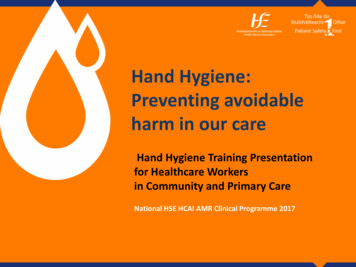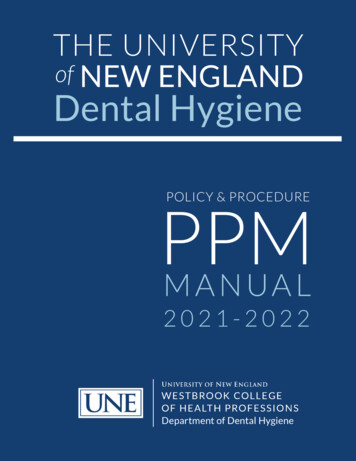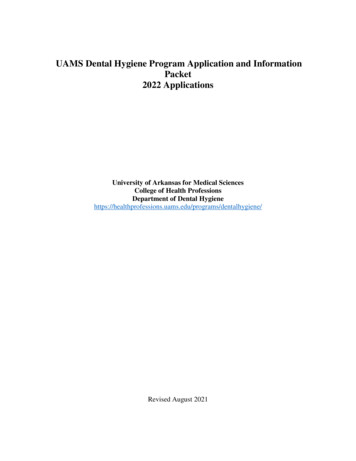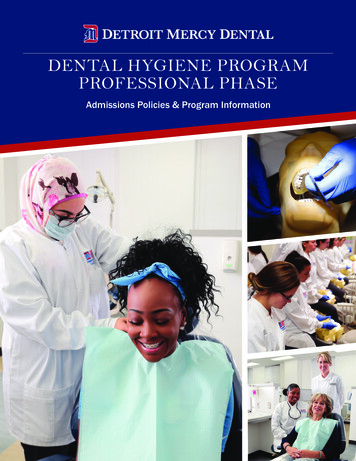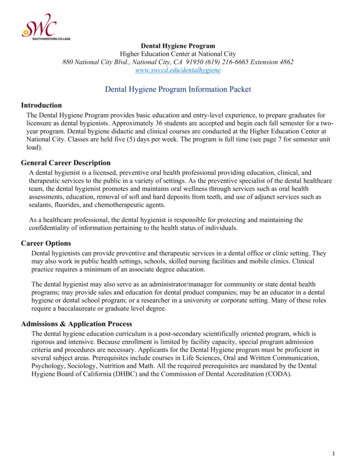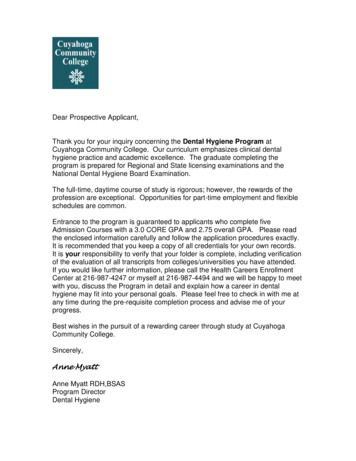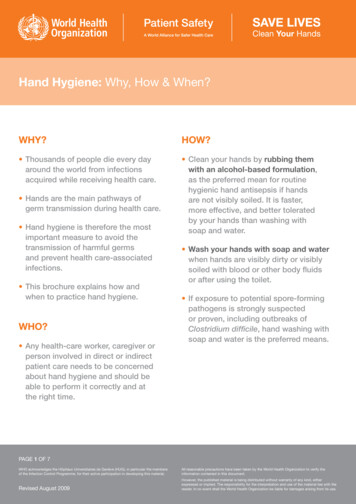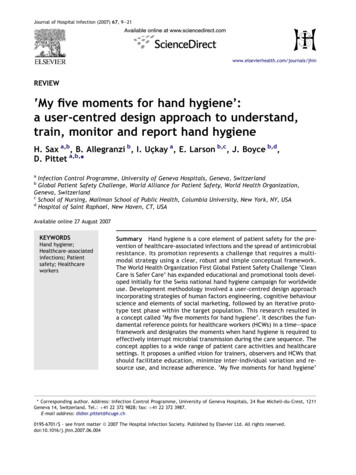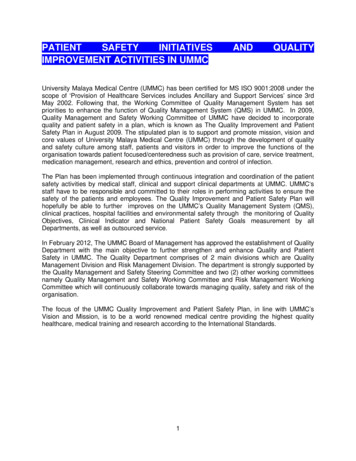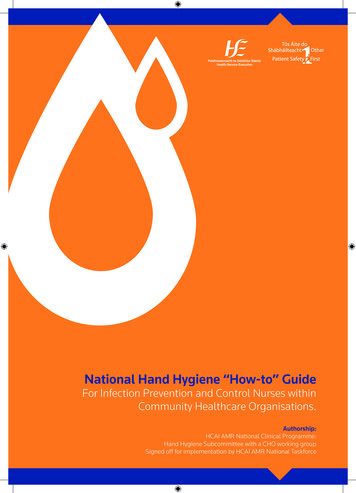
Transcription
National Hand Hygiene “How-to” GuideFor Infection Prevention and Control Nurses withinCommunity Healthcare Organisations.Authorship:HCAI AMR National Clinical Programme:Hand Hygiene Subcommittee with a CHO working groupSigned off for implementation by HCAI AMR National Taskforce
Contents:1:Introduction2:Governance protocol for hand hygiene Train the Trainer Programme3:Contractual agreement4:Getting started checklist13675:HCAI & AMR National Hand Hygiene Training Programme forCommunity and Primary Care Settings86:Hand Hygiene knowledge assessment7:Links to presentations8:Programme evaluation9:Template for training records10:Hand hygiene facility checklistGlossary of terms:AMRAntimicrobial ResistanceCHOCommunity Healthcare OrganisationsCIPCNCommunity Infection Prevention Control NursesHCAIsHealthcare Associated InfectionHCWHealthcare workersHHHand Hygiene911121314
1: Introduction:1.1 Aim of the Hand Hygiene “How to Guide” Programme:To deliver a standardised Hand Hygiene (HH) training programme and resources for all health care workers (HCW) inPrimary Care, Mental Health, Social Care and Health & Well Being divisions. The programme is evidence based and aims tocomply with national and international Hand hygiene guidelines (SARI 2005; WHO, 2009 & 2012, and RCPI/ HPSC, 2015)2015 reviewed Hand Hygiene Guidance1.2 Background:Hand Hygiene is recognised as the single most important measure in preventing the transmission of healthcare associatedinfections (HCAIs) particularly in health and social services (WHO, 2009 page 9). Compliance by HCWs with recommendedhand hygiene frequencies and techniques has been reported as variable to suboptimal. One of the key objectives of theNational HCAI Antimicrobial Resistance (AMR) Clinical Programme and Clinical Advisory Group (CAG) is to introduceinitiatives that will reduce HCAI and AMR including improvements in hand hygiene. This has been supported by thefollowing: The WHO 2009 Multimodal Hand Hygiene Strategy, The ‘My 5 moments of Hand Hygiene’ model In 2009 HIQA introduces Standards for Infection Prevention and Control (IPC). Standard 6. Is wholly dedicated to handhygiene In 2010 the Irish National hand hygiene guidelines were developed and were updated in 2015 By June 2011 Public acute hospitals were undertaking HSE National Hand Hygiene Observational Audits twice a year.With results being published to document the status of hand hygiene compliance within the Irish acute hospital sector The Introduction of WHO “Clean Hands Saves Lives” campaign 20121.3 Acute HospitalsOver the last number of years there has been improved compliance by HCW reported. Please see a report from 2016 on theHealth Protection Surveillance Centre website Period 10A number of initiatives contributed to this: Introduction of mandatory hand hygiene education on induction and every 2 years Introduction of alcohol gels Observational audits Feedback and local promotion activities1.4 CHOsThe standard achievable for hand hygiene compliance within CHO settings remains the same as to what is required withinthe acute care sector. However, hand hygiene training and the ability to ensure that all staff in CHOs receives hand hygienetraining is significantly different. This has been attributed to by: Current deficits in the availability of IPC resources across the geographical spread. Lack of effective governance structures to implement and monitor training. U nlike the acute care sector, many of the services and facilities where healthcare and social care is delivered are morediverse and complex such as patient’s own homes, residential care settings and primary care/outpatient facilities.Mandatory hand hygiene education of all healthcare workers was introduced by the HSE which has been supported by faceto face training and an e-learning module. Although the HSE e-learning module is available to staff in CHOs, anecdotalreports suggest that there are limitations in staff gaining access to and completing the e-learning.1
Face – to - face training is recognised as an effective option to support mandatory education of staff within the diversehealthcare settings previously described.1.5 What is the “How to Guide” for Hand Hygiene in Non-Acute -Settings?A suite of standardised educational hand hygiene materials have been developed to ensure consistency in the standard ofeducation being delivered which includes: S upporting governance protocol to ensure appropriate corporate implementation of hand hygiene educationthroughout non acute settings nationally Contractual agreement S tandardised materials for a ‘Train the Trainer’ education day for delivery by IPCNs to nominated trainers who aresupported by the CHO and the lead of their facility or service S tandardised ‘Train the healthcare worker’ presentation to be delivered by power point or manually by the handhygiene trainer to HCWs in their workplace. The presentation will include training and education materials on: Importance of Hand Hygiene How and when to perform hand hygiene using the 5 moments for Hand Hygiene (WHO 2009 and 2012) Hand washing – preparation, products, indications, glove use and technique Use of alcohol based hand rubs (ABHRs) – preparation, products, indications and technique Hand washing – preparation, products, indications, glove use and technique Skin care A checklist of the essential hand hygiene requirements in the health care setting Knowledge quesionnaires1.6 What is a “Train the trainer” Hand Hygiene programme?It is a quality improvement initiative developed in conjunction with a sub -committee of the HCAI AMR Clinical Programmeand a representative group of CIPCNs. A train the trainer approach with a how to guide has been developed to bridge thegap in education of hand hygiene in non -acute settings.This approach was adopted based on the success of two programmes which were developed independently in Cork/Kerry and Donegal by local IPCNs and with support from their local Centre for Nursing and Midwifery Education Centres(CNMEs).Governance has been identified as a key factor in supporting the train the trainer approach. Appropriate governancewill ensure that all healthcare workers receive mandatory hand hygiene training, particularly in areas where e-learningmodules are not widely accessible.2
2. Governance and Implementation of Hand HygieneTraining Programme in CHOs:2.1 Who will deliver the Hand Hygiene training programme to the trainers?Following implementation of the governance protocol for hand hygiene across each CHO, the CIPCNs in each CHO willundertake delivery and co-ordination of the hand hygiene ‘Train the trainer’ programme. This CIPCN will have an acuteawareness and understanding of the complexities of non-acute health and social care settings.2.2 Who will the programmes be available to?Hand Hygiene ‘Train the Trainer’To become a trainer for Hand hygiene in the non acute setting the following is the eligibly criteria: Worked as a HCW for approx 3 years Experience in providing formal/informal education or influence in making healthcare improvement Nominated with agreed support from service/facility manager Some prerequisites include: Interested in educating peers in hand hygiene and becoming a champion in the workplace Complete HSELand E-learning module on hand hygiene Complete HSELand E-learning module on Standard Precautions, “Breaking the Chain of Infection” Complete the ‘Train the Trainer’ education programme delivered by the IPCNHand Hygiene ‘Train the Health care worker’: T rainers who have undertaken the steps above will deliver hand hygiene training to HCWs in their healthcare facility/area of service who are required to undertake mandatory hand hygiene education on induction and every two years2.3 Roles and Responsibilities:2.3.1 HCAI AMR Clinical Programme Development and updating of ‘hand hygiene How to guide’ in association with a subgroup of IPCNs working acrossCHOs Support and advisory role to HCAI AMR taskforce on content and implementation across CHOs Advisory role to CHO HCAI AMR committees on monitoring measures for hand hygiene E ditorial responsibility to review and update content of the How to guide at least every 2 years or more often asemerging evidence requires. Promote awareness of the How to Guide2.3.2 Responsibility of National HCAI/ AMR Task forceIt is the responsibility of the National HCAI/ AMR Task force to; Ratify the train the trainer governance protocol and toolkit as one that can be used by all IPCNs working in primaryand community care within CHOs E nsure that within all CHOs, responsibility for oversight of this initiative will be supported from executive level as apriority national quality improvement for HCAI and AMR Monitor progress with mandatory hand hygiene training in CHO areas e.g. Number of Trainers trained at CHO level Number of HCWs who have received hand hygiene training3
2.3.3 Responsibility of Chief OfficersIt is the responsibility of each Chief Officer to; E nsure that a HCAI/ AMR committee is in place with an identified co-ordinator who will oversee that each healthcare facility/service within their area will provide a nominated HCW to undertake a train the trainer programme inhand hygiene: H ave in place within each CHO, records of nominated trainers for each facility/service. The list will include thename(s) of the CIPCNs where present in a CHO area E nsure that each facility/service make provision to release staff for training as Trainers, and facilitate release of allstaff to attend training, when required. E nsure that CIPCNs are available within the CHO to deliver the train the trainer programme. In the absence of aCIPCN this may involve sourcing a locum IPCN service where IPCN resources are not currently available within theCHO E nsure that there is a robust system in place whereby the training records of each trained ‘hand hygiene trainer’ canbe recorded and kept up-to-date on whatever systems are required within each CHO Area, such as PPARRs, servicemanager staff databases, facility training data bases, the trainers log etc. Administrative support is a necessarycomponent of the process. It is vital to ensure that the Lead CIPCN and the local group of hand hygiene trainershave access to administrative support which will record hand hygiene training as per each CHO areas requirements Agree local hand hygiene monitoring measures appropriate to the service/facility in conjunction with CIPCN advice.2.3.4 Infection Prevention Control Nurse:2.3.5 It is the responsibility of the CIPCN to; Provide the ‘Train the Trainer’ Hand Hygiene programme to the nominated trainers from facilities/services withintheir remit in CHO areas. This may be supported in conjunction with Centres of Nursing/ Midwifery Education (CNE/CNMEs) Review ‘Train the trainer’ delivery checklist in advance of the programme being delivered Provide hand hygiene support locally on request where possible Support hand hygiene Trainers by: Providing up- to- date information on products and facilities etc Providing resources and support to promote HCWs undertaking self evaluation/self appraisal of hand hygienetechnique (Section 5) along with other tools e.g hand hygiene inspection cabinet2.3.6 Health Care Facility Manager/ Head of ServiceIt is the responsibility of the Health Care Facility Manager/Head of Service to; T o recruit a HCW to undertake the train the trainer programme and complete contractual agreement (Section 3) T o provide protected time for a nominated trainer from their facility to undertake the train the trainer programmeprovided by the CIPCN, prepare and deliver training to all healthcare workers T o notify all staff of the role of the trainer T o ensure all HCWs are released to attend the training T o ensure that all new HCWs receive hand hygiene education by informing the trainer when new employees are dueto commence duty T o ensure availability of training resources including laptop projector where relevant and access to a hand hygieneinspection cabinet T o facilitate administration of the hand hygiene training programme Administration of programme includes record keeping for those who have received training, and issuingreminders to HCWs when hand hygiene education is required. This is currently 2 years These records are currentlyrequired during HIQA unannounced inspections of acute hospitals against IPC standards which are intended tocommence in the non- acute healthcare settings4
T o address non- compliance in line with national Hand Hygiene Guidelines. Local arrangements should be in placeand the following are a guide: Highlight the noncompliance with hand hygiene when observed Initial response at local level – ward or unit Arrange education and reassessment to be carried out Further action required – e.g. report to senior management These non- compliance issues include: Ensures compliance with ‘The 5 moments of Hand Hygiene’ as it applies in the individual health and social caresetting: Ensuring that no wrist or hand jewellery or are worn in clinical settings with the exception of a plain band ring Long nails, nail varnish or artificial nails Ensure compliance with “bare below the elbow/baring wrists” during all clinical and personal care activities (e.g.Short sleeved tops or rolled up sleeves prior to commencing suce care activities))2.3.7 Hand Hygiene Trainer:It is the responsibility of the Hand Hygiene trainer to: To undertake the ‘Train the Trainer’ hand hygiene programme To deliver the hand hygiene training to HCW in their service area/healthcare facility (using standardised materialssection 6) To attend a hand hygiene update every 4 yrs and relevant training as required To promote and be a champion in their service area/healthcare facility e.g. feedback using the hand hygieneenvironmental checklist (Section 4) Provide information to patients, residents, families and carers about the need for hand hygiene and how to keep theirhands clean Note: This role should be supported with approved professional development enhancements such as ‘Nursing andMidwifery Board of Ireland (NMBI/ An Bord Altranais) approved credits or Continuing Education Units (CEUs) points.2.3.8 Healthcare worker:It is the responsibility of each HCW to: Complete mandatory hand hygiene education on induction and every 2 years thereafter, either face- to- face oronline Comply with, act as a role model and promote with hand hygiene best practice at all times Provide information to patients, residents, families and carers about the need for hand hygiene and how to keep theirhands clean Note: The ‘How to guide for hand hygiene’ in CHO settings has been developed to support CHOs in providingmandatory hand hygiene education for HCWs. It is recognised that there are currently a small number of areas withinparticular geographic locations of CHOs where successful sustained ‘hand hygiene Train-the-Trainer programme’ orequivalent is already in place and delivered by the IPCN service. In these circumstances there should be no obligationfor existing programmes to be replaced at the discretion of the IPCN.References1. H ealth Information and Quality Authority. National Standards for the Prevention and Control of Healthcare Associated Infections. Dublin: HealthInformation and Quality Authority; 20092. World Health Organization. A Guide to the Implementation of the WHO Multimodal Hand Hygiene Improvement Strategy. Revised August 2009.3. Guidelines for Hand Hygiene in Irish Healthcare Settings https://www.hpsc.ie/InfectionControland HAI/Guidelines5
3: Hand Hygiene Trainer Contractual AgreementHead of Service/Head of Facility and nominated Hand Hygiene Trainer to complete in advance of Hand Hygiene Trainer theTrainer Training DayCHO Area NumberMental HealthSocial Care ServicePrimary care ServiceName and Location of Service/ FacilityName and Designation of Person in Charge of Service/Facility:Head of Service/FacilityI have read and understand the requirements in the Hand Hygiene Governance Protocol. I have discussed and agreedthe outlined supports required with the healthcare worker nominated within the facility to undertake the Train theTrainer roleName of Healthcare worker Undertaking Hand Hygiene Trainer Programme:I agree that becoming a Hand Hygiene Trainer :I will commit to attending the training onIn advance of attending the training I will : Have read and understood the Hand Hygiene Train The Trainer requirements outlined in the Governance Protocol Have undertaken Hand Hygiene and Breaking the Chain of Infection training on HSELand. Attend a Refresher Training Programme where required.Date:Signed:ParticipantHead of Service/Head of Facility6
4: Getting Started ChecklistTips for IPCNs in getting started with implementing Hand Hygiene Train The Trainer ProgrammeBased on feedback and experience of 4 Train the Trainer Programme Pilots in CHO areas1. Identify support through the HCAI Committee from CHO Management , Head of Service /Facility and CNME to runthe training prograamme.2. Communicate to the community and primary care service availability of training programme date, time and venue withattachment of governance protocol and contractual agreement for completion.3.Having a pre meeting/teleconference with key people involved is beneficial in planning the training .4. Identify a suitable training facility for number of trainers ( suggest 12 per one IPCN and maximum of 20 where2 IPCNs are running the programme) with provision of adjacent hand wash facilities and hand hygiene inspectioncabinets5. Prepare PowerPoint slides , Knowledge assessment forms , Governance protocol, Environmental audit tool, evaluationforms and any other documents you wish to use for trainer packs on the day.6. Presentation folders for Trainers to use following completion of training may be located through HCAI AMRProgramme as available.7.Organise the use of 2 hand hygiene inspection cabinets ( if possible)for the training8. Arrange NMBI credits with the support of the CNME locally ( The HCAI AMR Programme are currently looking at thefeasibility of getting these credits processed nationally)9. It is important that evaluations are completed by everyone following the training. Forward the feedback evaluations forsummarising electronically to mary.mckenna@hse.ieFor any queries you may have in relation to the previous experiences of IPCNs who have tested the Train the Trainerprogramme, the following contacts may be usefulMags Moran: mags.moran@hse.ieNoeleen Hallahan: Noeleen.hallahan@hse.ieAnne O Connor: annem.oconnor@hse.ieMichelle Bergin: michelle.bergin@hse.ieJulie Meally: Julie.Meally@hse.ie7
5: HCAI&AMR National Hand Hygiene TrainingProgramme for Community and Primary Care SettingsHand Hygiene Train The Trainer Programme iew of Train the Trainer role9.45-10.15When do we clean our hands?10.20- 10.40Break10.40-11.20Getting to grips with the 5 moments for hand hygiene11.20-12.00Practical Workshop : indications for hand hygiene12-12.45Demonstration of hand hygiene technique and self assessment12.45-1.30Lunch1.30-2.30Glove use and challenges in hand hygiene2.30-3.30Train the trainer presentation explained3.30-4.00Review of next steps as the Hand Hygiene Trainer and Hand Hygiene Environmental checklist4.00-4.15Completion of MCQ part 24.15-4.30Evaluation of the Train the Trainer Programme8
6: Hand Hygiene Knowledge AssessmentNational Quality Improvement Initiative Hand Hygiene (HH)Knowledge assessment:Part One:To be completed by participants prior to receiving training:All questions are applicable:1.Artificial nails, nail polish or long nails can be worn at workT / F2.When carrying out hand hygiene it is acceptable to wear one flat ringT / F3.Rings with stones and long sleeved tops can be worn when providing careT / F4.Any cut or graze on hands should be covered with a waterproof dressingT / F5.Nailbrushes should be routinely used for handwashingT / F6.Alcohol hand rub should only be used on visibly clean handsT / F7.After using an alcohol hand rub hands must be allowed to dry completelyT / F8. Alcohol hand rub alone is sufficient to clean hands after caring for a patientwho has diarrhoeaT / F9.Gloves should be worn for all care activities10. Gloves must always be worn when in contact with body fluidsT / F11. Gloves should be worn when handling used bed linenT / F12. Hand hygiene must always be carried out after removing disposable glovesT / F13. Antiseptic hand hygiene is achieved using alcohol hand rub on visibly clean hands forduration of 30 secsT / F14. Antiseptic hand hygiene is required before invasive procedures of aseptic techniqueT / FList the five moments/indications for performing hand hygiene:12345Thank you for completion9
Part Two:To be completed by participants when training has been completed:All questions are applicable and more than one answer may apply in some questionsQuestion1.AnswerWhich of the following is moment 2 of 5 moments of hand hygiene?a. After body fluid exposureb. After touching a patient’s surroundingsc. Before touching a patientd. Before a clean/aseptic procedure2.In which of the following situations is the use of alcohol hand rub most appropriate?a. Before a clean/aseptic procedureb. When hands are visibly soiled with body fluidc. After caring for a patient with known or suspected Clostridium Difficiled. When hands are visibly soiled with dust3.Why is hand hygiene recommended before touching a patient (Moment 1)?a. To protect the heathcare worker from the patient’s microbial florab. To protect the patient from micro-organisms present on the healthcare workers handsc. To prevent contamination of environment from the patient’s microbial florad. To prevent contamination of equipment and surfaces4.In which of the following situations should hand hygiene always be performed?a. before a clean/aseptic procedureb. After removing glovesc. Before answering the phoned. after touching a patient surroundings5.Healthcare associated infections (HCAIs) refers to:a. Infection acquired after receiving care in primary and community care settingsb. Infection acquired in a restaurantc. Infection acquired after receiving healthcare in an acute settingd. Infection acquired by healthcare6.Hand hygiene refers to:a. Hand washingb. Cleaning handsc. Shaking handsd. Hand decontamination7.Which of the following helps to protect your skin?a. Drying your hands thoroughly after hand washingb. Always wearing gloves when touching a patientc. Use an alcohol hand rub with added emollientd. Regularly using a hand moisturiser approved for use in healthcare settings8.Which of the following is moment 5 of the 5 moments of hand hygiene?a. After body fluid exposure riskb. After touching a patient’s surroundingsc. Before touching a patientd. Before a clean/Aseptic procedure9.Which of the following should you undertake if your hands are visibly soiled?a. Put on glovesb. Undertake hand hygiene using alcohol hand rubc. Use a paper towel to wipe your handsd. Undertake hand hygiene using liquid soap and water10.Which of the following is not used for hand hygiene in healthcare settings?a. Alcohol hand rubb. Liquid soapc. Bleachd. Antiseptic soap10
7: List of Training PresentationsPresentation 1Healthcare worker training sentation 2Train the trainer11
8: Programme yDisagreeCommentsTopics and content were wellorganised and interestingFormat including activities andpresentation style was appropriateto the needs of the groupParticipant questions and concernswere addressed, the responsesprovided for further learningI can relate the concepts to my roleand apply what I have learned ashand a hygiene trainerThe content was well administeredOverall I am very satisfied with theHand Hygiene train the TrainerProgrammeWhat worked well with the Hand Hygiene Train the Trainer Programme?How could future training could be improved?How do you propose to deliver Train the Healthcare worker training?Powerpoint with computer/laptopUsing a Flip Chart with presentationAdditional Comments or information12
9: Template for Training RecordsHand Hygiene Training RecordHand Hygiene Trainer Name CHO NumberName of Healthcare Facility/ServiceDateNamePersonnel NumberCategory of StaffDepartmentPlease keep a copy of the training record and send copy to head of Service/ Head of facility13
10: Hand Hygiene Facility ChecklistHand Hygiene Facility ChecklistCHO Area No.DateName of Healthcare Facility/Service:Completed by:Results reported to :Question1HCWs have received training in hand hygieneprocedures within the last 2 years. (Ask HCWs onduty / check training records2HCWs nails are short and clean and free from nailpolish (including gel nails//enhancements)3No wrist watches, stoned rings or other wrist jewellery are worn on duty by HCWs on duty (A singleplain band ring only)4HCWs are observed to have bare wrists whendelivering care (e.g. Short sleeved top or rolled upsleeves)5Dedicated clinical hand wash sink with hot water,soap and paper towel is available where care isprovided with unobstructed access6Alcohol handrub is available for use at the point ofcare e.g. wall mounted/ bottles and are accessiblewhen providing care7Posters demonstrating technique are prominentlydisplayed8Pump operated or wall mounted hand lotions /cream is available and in date for staff and theyare aware of the locationAnswerY/NComment14
Main author address for communication or further queries to:Mary Mc KennaInfection Prevention and Control ADONNational HCAI AMR Response Teammary.mckenna@hse.ieAcknowledgements to the following community IPCNs whoseprevious experience and materials have been supportive indeveloping the Hand Hygiene Train the Trainer Programme:Mags Moran CHO1Liz Forde CHO4Patricia Coughlan CHO 4
HCAIs Healthcare Associated Infection HCW Healthcare workers HH Hand Hygiene 1: Introduction 1 2: Governance protocol for hand hygiene Train the Trainer Programme 3 3: Contractual agreement 6 4: Getting started checklist 7 5: HCAI & AMR National Hand Hygiene Training Programme for Community and Primary Care Settings 8 6:
